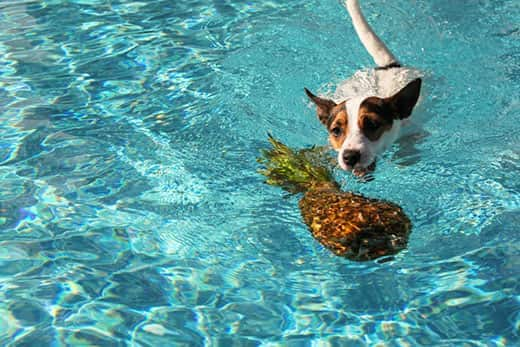
Pineapple for a dog: benefits and harms
Pineapple is a great garnish for tropical drinks and a delicious addition to fruit salad, but is it safe for dogs? In principle, the owners have nothing to fear. When eaten in moderation, fresh pineapple can be a nutritious treat for your four-legged friend.
Can dogs eat pineapple
 Fresh pineapple is rich in B vitamins and vitamin C. It is also high in minerals and electrolytes, including potassium, magnesium, iron, and zinc. According to the American Kennel Club, many of the nutrients found in pineapple can help your pet’s immune system and promote digestive health.
Fresh pineapple is rich in B vitamins and vitamin C. It is also high in minerals and electrolytes, including potassium, magnesium, iron, and zinc. According to the American Kennel Club, many of the nutrients found in pineapple can help your pet’s immune system and promote digestive health.
Fresh pineapple can be a healthy treat for your four-legged friend if given in small amounts. However, canned and dried pineapple sometimes contains refined sugar, which increases the calorie content of the product. Dogs don’t need extra calories.
Is pineapple safe for dogs?
No matter how nutritious pineapple is, eating it is fraught with some risks. Although high-fiber foods can be beneficial in small amounts, too much of them can cause digestive problems, including diarrhea and constipation. For pets with sensitive stomachs, even small amounts of pineapple can cause digestive problems.
The fruit also contains natural sugars that can be dangerous for dogs with or at risk of developing diabetes, The Labrador Site explains. The high content of acids in pineapple can lead to abrasion of tooth enamel and accelerate tooth decay.
Do not feed the prickly outer skin and tough core of the pineapple to your dog. This can lead to intestinal blockage.
It’s best to call your veterinarian if your pet digs through the trash and eats one of these pineapple parts. The specialist will advise whether to bring the dog in for an examination or to observe a little first.
How to give pineapple to a dog
To safely treat your dog to pineapple, you need to follow the recommendations:
- Before feeding, consult with your veterinarian to ensure that your dog does not have any underlying medical conditions for which pineapple is contraindicated, including diabetes.
- Peel the pineapple from the peel and core, throwing them where the dog can’t get to them.
- Cut the pineapple into cubes for a large dog or finely chop for a small one.
- If your dog is eating a pineapple for the first time, give him one bite and wait an hour to see if he shows signs of digestive problems. If you have any of these signs, you should no longer give this fruit to your four-legged friend. Any treats should make up no more than ten percent of a dog’s daily calorie intake.
- Give your dog no more than two or three small pieces of pineapple per day.
Pineapple in moderation makes for a pleasant snack that your dog may enjoy. The main thing is not to overdo it and not let the pet get carried away with this sweet treat so that it replaces those foods in her diet that she really needs for health.





